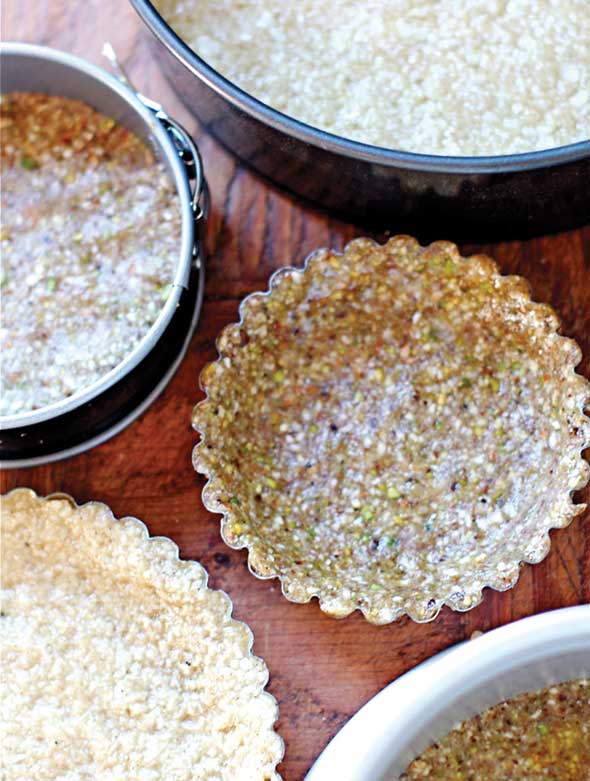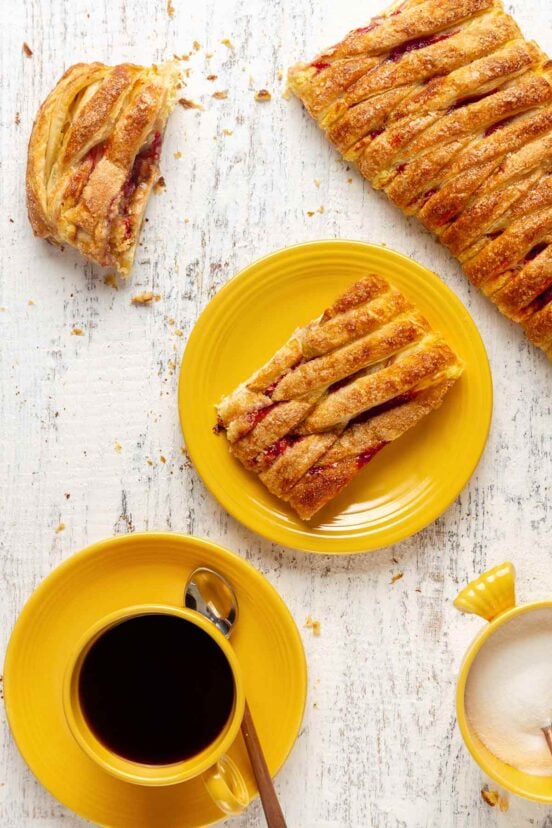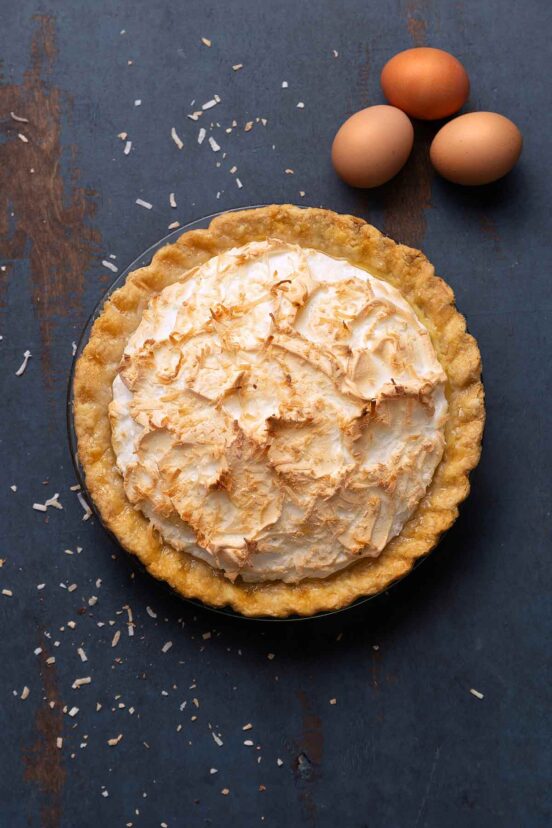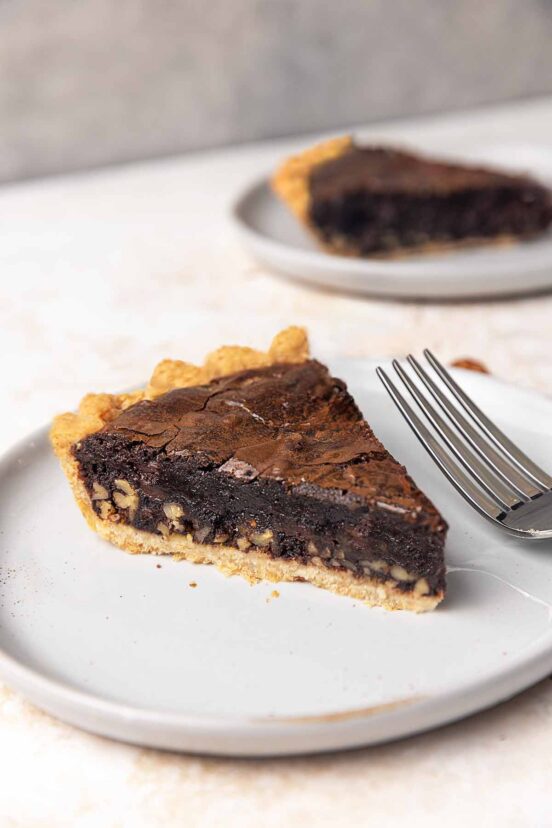
LC Vegan? Nods. GF? Yep. Paleo? Yeah, That Too. Note
Not only is this paleo pie crust recipe most undoubtedly identical to what paleolithic home cooks tossed together and carefully crimped when they made pumpkin pie, it’s devoid of any gluten as well as anything that would offend any vegans at the table. Talk about a recipe for a happy Thanksgiving.

Vegan, Gluten-Free, and Paleo Pie Crust
Ingredients
- 1 1/2 cup mixed nuts or seeds, (such as 1/2 cup almonds, 1/2 cup Brazil nuts, 1/2 cup pecans)
- 1/2 cup dried fruit, (such as dates)
- 1 teaspoon vanilla extract
Instructions
- Place the nuts, dates, and vanilla extract in a food processor and process until a fine crumble forms and sticks together.
- Remove the crust mixture from the processor and press it into a pie or springform pan using fingertips lightly dampened with water to prevent sticking. Pat the crust evenly into the pan.
- Proceed with any baked pie and bake according to the recipe. (Due to the relatively high amount of natural sugar in this paleo pie crust, it may brown more quickly than most pie crusts. We suggest you keep a watchful eye on the crust and, if it threatens to turn a darker shade of brown than desirable, rip off a long strip of aluminum foil and loosely crimp the foil around the edge of the pie to cover just the crust, not the filling.)
Notes
Paleo Pie Crust Variations
You can vary those ingredients according to your own tastes. First, you choose a base ingredient, usually a nut or seed. Once you’ve selected your desired nuts, choose a binder. Dried fruits such as dates, raisins, apricots, or cranberries make excellent binders. The goal is to find the right ratio of binder to base. Depending on the moistness of your binder, you may have to play with the proportions to get the right balance. In the event your crust is not binding, add a little more dried fruit, but just enough to help the ingredients stick together—too much and you’ll end up with a mushy crust. A pinch of salt helps bring out the flavors. As with anything you create, let your imagination come out to play. Just tweak the recipe as your taste buds dictate. You can further customize your crust with flavor add-ins. Citrus zest, extracts like vanilla and almond, cacao powder, cacao nibs, and spices like cinnamon, ginger, and nutmeg all make wonderful additions.Nutrition
Nutrition information is automatically calculated, so should only be used as an approximation.
Recipe Testers’ Reviews
Loved this recipe! So easy and delicious. With Canadian Thanksgiving at the time of this recipe testing, I decided to give this paleo pie crust a try for pumpkin pie. What I really like about this recipe is the versatility and customization. You can use any combination of nuts and seeds. I love pecans, walnuts, and Brazil nuts, so I used those and since I was making pumpkin pie I added some pumpkin seeds as well for a total 1 1/2 cups. For the sweetener I used about 8 Medjool dates. I also added 1/2 teaspoon cinnamon, a pinch freshly grated nutmeg, salt, and vanilla. Everything came together very easily in the food processor. At first I used the pulse function and then just let the machine run a couple of minutes. When I tried pressing the mixture together to check for how well it binded, my mixture was a bit more on the dry side so I added another date and that worked. Pressing the crumble into the pie pan was easy. I started working at the sides and then pressed in the middle. At first I used my hands, but then used the back of a spoon to get a smooth, even surface. I poured in the pumpkin pie mixture and baked it. Unfortunately, the exposed crust burnt in the baking process. I guess the fat from the nuts and sugar from the dates contributed to this and I never thought it would be an isssue. But now that I have experienced this, I will cover the crust midway with aluminum foil in the future. The nuttiness of the crust went very well with the pumpkin pie and having a non-grain crust option was great! I can’t wait to try this crust with an crumble fruit pie. I think apples will be next!
If you have people with dietary restrictions coming to visit, this paleo pie crust ticks off a lot of checkboxes. Vegan, raw, paleo, gluten-free. If you are dealing with nut allergies, well, you may be SOL. This crust is based on a standard that’s been used among the raw food types for years. And there’s a good reason for this—it works. For my test of this recipe, I used a combination of hazelnuts and pecans. I used Medjool dates for the sweetener and binder. When you blend it all together in the food processor, be patient. It might take a little longer to come together than you expect, but you will be rewarded with a better crust. This crust is great for certain types of pies, but it can’t do everything. It will work wonderfully with a cheesecake or a no-bake pumpkin pie. It won’t work for a double crust pie or lattice pie. Anywhere you might use a crust made of graham crackers or crushed cookies, this crust will shine, and probably even be superior. So plan accordingly. Since the crust is vegan and raw, I used it for a vegan and raw key lime pie, and it was perfect for that application. You can also flavor this crust with extracts, citrus zest, or a little coconut mixed in. I used this in a 9-inch pie pan and had a little left over. The amount would be sufficient for a 10-inch tart pan. That’s a good thing.
If you want something to satisfy your paleo cravings for pies, this is your ticket. I used deluxe mixed nuts from the local bulk store, unsalted and unroasted. It was a mix of pistachios, peanuts, walnuts, almonds, and Brazil nuts. I put my crust mix into a square tart tin to make cheesecake. I prebaked the crust for 10 minutes to set it before filling it. It held up really well, and I can’t wait to try it again. I know I’ll be making it in the future, and I want to see how it does with brown rice syrup as the binder in place of dates.
This paleo pie crust is a super easy recipe to make. Time-wise, It took me 10 minutes from beginning to end. I decided to make it with 3/4 pecans and 1/4 Brazil nuts. For the binder, I used dates, as I love how they give the perfect amount of sweetness. And for those worried that they may not like dates, do not fret, as I absolutely avoid eating them on their own, but when puréed and mixed with nuts, the taste does not translate into the final product. I decided first to grind the nuts on their own. Once that was done, I added the dates and the vanilla extract. The final product was a nice thick paste mixture that was very easy to spread on the pan. I used this to make my go-to cheesecake, and it worked beautifully. I would also advise placing it in the oven for about 10 minutes at 350°F—just long enough to help it settle and dry a bit. Then let the crust cool prior to using it. Once the cheesecake was made, most people did not even realize the crust was nut-based. It kept its shape well, without crumbling, when I was slicing it.
















I’m trying to find a flour-free “playdoh” recipe, do you think the raw/uncooked crust dough would work as good base for this project? Thanks.
Kathryn, I’m so sorry, but I have no idea! What about this?
Thank you for this recipe and all who have added their thoughts and experience. It is with confidence now that I will go forward to give it a try for our upcoming family gathering!
You’re more than welcome, Janet!
Question! How well does this “crust” hold when it comes out of the pan? Should the pan be greased before pressing the mixture in?
We didn’t have any issues, Elle. You could lightly butter the pan to be safe, or line it with parchment paper if you wish. Like any crumb crust (think of those made with graham crackers or cookies) it may crumble just a touch when you take a slice out of the pan but actually none of us experienced that.